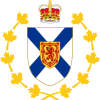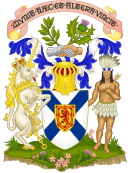Lieutenant Governor of Nova Scotia
| Lieutenant Governor of Nova Scotia | |
|---|---|
 Emblem of the Lieutenant Governor | |
 Flag of the Lieutenant Governor of Nova Scotia, since 1929 | |
| Viceroy | |
| Style | His Honour the Honourable |
| Residence | Government House, Halifax |
| Appointer | Governor General of Canada on the advice of the Prime Minister |
| Term length | At the Governor General's pleasure |
| Formation | 1 July 1867 |
| First holder | Sir Charles Hastings Doyle |
| Website | lt.gov.ns.ca |
The lieutenant governor of Nova Scotia (/lɛfˈtɛnənt/) is the viceregal representative in Nova Scotia of the Canadian monarch, Queen Elizabeth II, who operates distinctly within the province but is also shared equally with the ten other jurisdictions of Canada, as well as the other Commonwealth realms and any subdivisions thereof, and resides predominantly in her oldest realm, the United Kingdom. The lieutenant governor of Nova Scotia is appointed in the same manner as the other provincial viceroys in Canada and is similarly tasked with carrying out most of the monarch's constitutional and ceremonial duties.[1] The present, and 33rd lieutenant governor of Nova Scotia is Arthur Joseph LeBlanc, who has served in the role since 28 June 2017.
Role and presence[]
The lieutenant governor of Nova Scotia is vested with a number of governmental duties and is also expected to undertake various ceremonial roles. For instance, the lieutenant governor acts as patron, honorary president, or an honorary member of certain Nova Scotia institutions, such as the , the , and the Royal Canadian Legion (Nova Scotia-Nunavut Command).[2] Also, The viceroy, him or herself a member and Chancellor of the order,[3] will induct deserving individuals into the Order of Nova Scotia and, upon installation, automatically becomes a Knight or Dame of Justice and the Vice-Prior in Nova Scotia of the Most Venerable Order of the Hospital of Saint John of Jerusalem.[4] The viceroy further presents numerous other provincial honours and decorations, as well as various awards that are named for and presented by the lieutenant governor; these are generally created in partnership with another government or charitable organization and linked specifically to their cause.[5] These honours are presented at official ceremonies, which count amongst hundreds of other engagements the lieutenant governor partakes in each year, either as host or guest of honour; the lieutenant governor in 2006 undertook 289 engagements and 384 in 2007.[6]



At these events, the lieutenant governor's presence is marked by the lieutenant governor's standard, consisting, unlike most other viceregal flags in Canada, of the Royal Union Flag defaced with the escutcheon of the Arms of Her Majesty in Right of Nova Scotia surrounded by a circle of 18 green maple leaves. This is the last of the Canadian governors' flags to retain the original design set out by Queen Victoria in 1869, though for a period in the 1950s, the lieutenant governor used a flag bearing simply the arms of the province.[7] Within Nova Scotia, the lieutenant governor also follows only the sovereign in the province's order of precedence, preceding even other members of the Canadian Royal Family and the Queen's federal representative.
The aides-de-camp who serve the lieutenant governor wear on their uniforms a badge consisting of the flag of the lieutenant governor in the form of a shield surmounted by a St. Edward's Crown. The Canadian Heraldic Authority designed the badge, with the authorisation on 20 May 2011 of Governor General David Johnston, as well as of Queen Elizabeth II for the use of the royal crown.[8]

History[]

The office of lieutenant governor of Nova Scotia came into being in 1786, when the government of William Pitt adopted the idea that Nova Scotia, along with New Brunswick, Quebec, and Prince Edward Island, should have as their respective governors a single individual. The earlier post of governor of Nova Scotia thus came to be occupied by the overreaching authority of the governor-in-chief, who was represented in the colony by a lieutenant. The modern incarnation of the office, however, was established in 1867, upon Nova Scotia's entry into Confederation.[9] Since that date, 30 lieutenant governors have served the province, amongst whom were notable firsts, such as Myra Freeman – the first female lieutenant governor of the province – and Mayann Francis – the first lieutenant governor of Black Nova Scotians ancestry. The shortest mandate by a Lieutenant Governor of Nova Scotia was Joseph Howe, for three weeks in July 1873, while the longest was Malachy Bowes Daly, from 1890 to 1900.
See also[]
References[]
- ^ Victoria (29 March 1867). "Constitution Act, 1867". V.58. Westminster: Queen's Printer. Retrieved 15 January 2009. Cite journal requires
|journal=(help) - ^ Office of the Lieutenant Governor of Nova Scotia. "The Lieutenant Governor of Nova Scotia > Role and Responsibilities > Patronage". Queen's Printer for Nova Scotia. Archived from the original on 2009-06-02. Retrieved 11 July 2009.
- ^ Elizabeth II (12 March 2007). "Order of Nova Scotia Act". 6. Halifax: Queen's Printer for Nova Scotia. Retrieved 21 June 2009. Cite journal requires
|journal=(help) - ^ "Canada Wide > About Us > The Order of St. John > The Order of St. John in Canada". St. John Ambulance Canada. Retrieved 2 June 2009.
- ^ Office of the Lieutenant Governor of Nova Scotia. "The Lieutenant Governor of Nova Scotia > Lieutenant Governor's Awards". Queen's Printer for Nova Scotia. Archived from the original on 22 April 2009. Retrieved 11 July 2009.
- ^ Berezovsky, Eugene (2009). Staff of Canadian Monarchist News (ed.). $1.52 per Canadian: The Cost of Canada's Constitutional Monarchy (PDF) (4 ed.). Toronto: Monarchist League of Canada. p. 3. Archived from the original (PDF) on 7 July 2009. Retrieved 15 May 2009.
- ^ Nelson, Phil (13 December 2008). "Flags of the World > Nova Scotia > Flag of the Lieutenant-Governor". Retrieved 11 July 2009.
- ^ Office of the Lieutenant Governor of Nova Scotia. "Government House > Badge of the Honorary Aides-de-Camp". Queen's Printer for Nova Scotia. Archived from the original on 20 October 2012. Retrieved 1 November 2012.
- ^ Victoria 1867, V.63
Further reading[]
Heard, Andrew (2020). "Chapter 2: The Provincial Crown and Lieutenant Governors". In Jackson, D. Micahel (ed.). Royal Progress: Canada’s Monarchy in the Age of Disruption. Dundurn Press. pp. 43–77. ISBN 978-1459745735.
Burke, Scott. Presiding by Desire: Nova Scotia's Popular Lieutenant Governor: Hon. MacCallum Grant. Halifax: Tellwell Talent. ISBN 978-0228824992.
McCreery, Christopher (2020). Government House Halifax: A Place of History and Gathering. Fredericton: Goose Lane Editions. ISBN 9781773102016.
McCreery, Christopher (2014). "Chapter 10: The Provincial Crown: The Lieutenant Governor's Expanding Role". In Jackson, D. Micahel (ed.). Canada and the Crown. McGill-Queen’s University Press. pp. 141–161. ISBN 978-1553392040.
Jackson, D. Michael (2013). The Crown and Canadian Federalism. Toronto: Dundurn Press. ISBN 978-145970988-1. Jackson, D. Michael (2012). "Chapter 1: The Crown in the Provinces: Canada's Compound Monarchy". In Jackson, D. Michael (ed.). The Evolving Canadian Crown. Dundurn Press. pp. 11–31. ISBN 978-1553392026.
Beck, J. Murray (1957). The Government of Nova Scotia. Toronto: University of Toronto Press. ISBN 978-1442651753.
Saywell, John T. (1957). The Office of Lieutenant-Governor. Toronto: University of Toronto Press. ISBN 0-773045538.
External links[]
| Wikimedia Commons has media related to Lieutenant Governors of Nova Scotia. |
- Lieutenant Governors of Nova Scotia
- Provincial and territorial political office-holders in Canada

